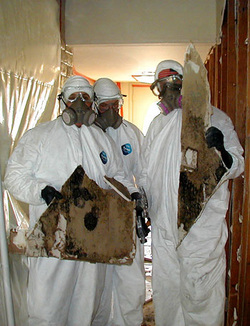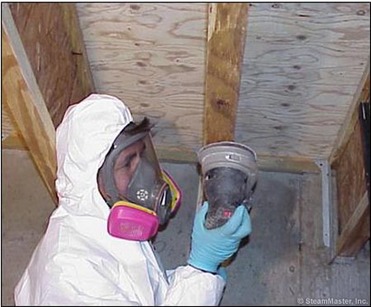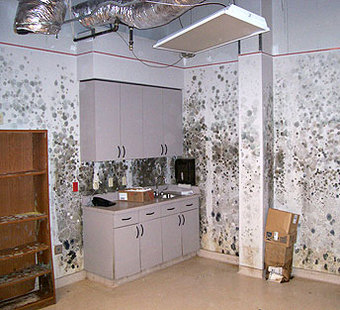Mold Removal in San Francisco
Professional mold removal companies in San Francisco and the Bay Area understand how serious mold damage and mold removal can be, for many reasons, most importantly your health. Depending on the type of Mold in your home, or on your property, it can have harmful side effects on your health like upper respiratory problems and lung cancer. All Mold removal San Francisco companies work with several different industrial hygienists and know how to read a scope of work so that we can get you property back to pre loss conditions. San Francisco water and mold damage must be contained to prevent cross contamination, disinfected to prevent mold spores in the air, and removed to prevent it from spreading.
Mold Removal in San Francisco Bay Area

Its important to understand that failure to remove any mold contamination, eliminate moisture, and humidity can cause serious long-term health risks. Flooding in a Water damage San Francisco home becomes a breeding ground for bacteria, fungi and mold. You and your loved ones can become victims of harmful viruses that can cause illness, disease and allergies.
Damage to possessions including books important documents, pictures, ceilings, walls and tiles can become damaged permanently. Our mold damage contractors in San Francisco provide businesses, homes and schools mold inspections, clean-up and vow to eliminate dangerous sources of moisture.
Many Bay Area people have not heard about San Francisco mold abatement despite the fact that it is the most crucial process related to mold growth. Mold abatement, more popularly known as remediation, is the defined as the procedure of removing, cleaning, sanitizing and demolishing of mold and/or mold-contaminated matter. Simply put, it is the process of eliminating mold from properties such homes, schools and offices. Mold releases allergens, irritants, as well as toxic substances. People who are exposed to mold for long periods of time can suffer from symptoms such as coughing, sneezing, runny nose, skin irritation and headaches. In worst cases, these people can acquire pneumonia and chronic lung illnesses. Hence, mold is dangerous enough to be life-threatening. Even dead mold can be a threat to one’s health. This is the primary reason why mold abatement should be done by professionals.
Damage to possessions including books important documents, pictures, ceilings, walls and tiles can become damaged permanently. Our mold damage contractors in San Francisco provide businesses, homes and schools mold inspections, clean-up and vow to eliminate dangerous sources of moisture.
Many Bay Area people have not heard about San Francisco mold abatement despite the fact that it is the most crucial process related to mold growth. Mold abatement, more popularly known as remediation, is the defined as the procedure of removing, cleaning, sanitizing and demolishing of mold and/or mold-contaminated matter. Simply put, it is the process of eliminating mold from properties such homes, schools and offices. Mold releases allergens, irritants, as well as toxic substances. People who are exposed to mold for long periods of time can suffer from symptoms such as coughing, sneezing, runny nose, skin irritation and headaches. In worst cases, these people can acquire pneumonia and chronic lung illnesses. Hence, mold is dangerous enough to be life-threatening. Even dead mold can be a threat to one’s health. This is the primary reason why mold abatement should be done by professionals.
San Francisco Mold Damage Tips
There are more than 100,000 types of mold. Some molds produce powerful chemicals called "mycotoxins" that can produce illness in animals and people - so don't take any chances.
In many situations, indoor mold growth may not be obvious. It is possible that mold may be growing on hidden surfaces, such as the back side of dry wall, wallpaper, or paneling, the top of ceiling tiles, the underside of carpets and pads, etc. Investigating hidden mold problems may be difficult and will require caution when the investigation involves disturbing potential sites of mold growth—make sure to use personal protective equipment or consult an environmental professional for help (e.g., an industrial hygienist or indoor air quality consultant).
Most importantly, the source of the water accumulation must be identified and fixed or fungal growth will continue to occur. If you have a high relative humidity in a room or area (55% or higher), then you should strongly consider a dehumidifier. To determine the relative humidity, you will need a relative humidity sensor, also known as a moisture meter or hygrometer.
Carefully remove and discard mold and mold-infested materials into heavy-duty plastic bags. Do not transport the bags throughout the house, especially other clean areas. Doing so will risk further spreading and regerminating of the mold.
San Francisco mold remediation practices state that all non-porous materials should be cleaned with a biocide, and all porous materials such as drywall should be removed and replaced. Bay Area mold is often found on sheetrock/drywall since the paper backing provides a great source of food. Sheetrock is porous and must be removed during remediation. When removing drywall due to mold contamination, 12-18 inches of additional drywall on all four sides of the contaminated area are removed. This clearly is a far more destructive process than cleaning, but this preventative measure is used to ensure that all mold is removed.
Wood framing members in a crawl space or attic and wooden studs within the walls are often sanded and cleaned to minimize the amount of reconstruction work. These structural members don't need to be removed, unless they have been seriously compromised due to dry rot. A containment area is set up in the problem areas to avoid cross contamination, which spreads mold spores into unaffected areas of the home. By using 2 plastic curtain doorways, there is minimal air disturbance during exit and entry. Within the containment area, a negative air machine is utilized. The purpose of a negative air machine is to ensure proper containment by removing air from the contaminated space faster than air from an uncontaminated space can enter.
Once all San Francisco mold remediation work has been completed, a mold clearance test is performed by an independant third party mold tester to avoid a conflict of interests to determine whether the remediation has been effective and that no previously unaffected areas have been contaminated. The final test should indicate that the mold levels have decreased since the original inspection and are lower than the outdoor control sample.
In many situations, indoor mold growth may not be obvious. It is possible that mold may be growing on hidden surfaces, such as the back side of dry wall, wallpaper, or paneling, the top of ceiling tiles, the underside of carpets and pads, etc. Investigating hidden mold problems may be difficult and will require caution when the investigation involves disturbing potential sites of mold growth—make sure to use personal protective equipment or consult an environmental professional for help (e.g., an industrial hygienist or indoor air quality consultant).
Most importantly, the source of the water accumulation must be identified and fixed or fungal growth will continue to occur. If you have a high relative humidity in a room or area (55% or higher), then you should strongly consider a dehumidifier. To determine the relative humidity, you will need a relative humidity sensor, also known as a moisture meter or hygrometer.
Carefully remove and discard mold and mold-infested materials into heavy-duty plastic bags. Do not transport the bags throughout the house, especially other clean areas. Doing so will risk further spreading and regerminating of the mold.
San Francisco mold remediation practices state that all non-porous materials should be cleaned with a biocide, and all porous materials such as drywall should be removed and replaced. Bay Area mold is often found on sheetrock/drywall since the paper backing provides a great source of food. Sheetrock is porous and must be removed during remediation. When removing drywall due to mold contamination, 12-18 inches of additional drywall on all four sides of the contaminated area are removed. This clearly is a far more destructive process than cleaning, but this preventative measure is used to ensure that all mold is removed.
Wood framing members in a crawl space or attic and wooden studs within the walls are often sanded and cleaned to minimize the amount of reconstruction work. These structural members don't need to be removed, unless they have been seriously compromised due to dry rot. A containment area is set up in the problem areas to avoid cross contamination, which spreads mold spores into unaffected areas of the home. By using 2 plastic curtain doorways, there is minimal air disturbance during exit and entry. Within the containment area, a negative air machine is utilized. The purpose of a negative air machine is to ensure proper containment by removing air from the contaminated space faster than air from an uncontaminated space can enter.
Once all San Francisco mold remediation work has been completed, a mold clearance test is performed by an independant third party mold tester to avoid a conflict of interests to determine whether the remediation has been effective and that no previously unaffected areas have been contaminated. The final test should indicate that the mold levels have decreased since the original inspection and are lower than the outdoor control sample.
San Francisco mold damage companies
The quality of service that you receive when you seek out a San Francisco Mold Damage Company services varies depending upon what company you choose, and choosing the wrong company can mean that mold is left behind in your home threatening your health.
Each step in the mold remediation process is critical, and you should ask your Bay Area mold remediation contractor what experience he has in the different areas. Ask about their experience, references, training, and warranty.
Ensure you mold removal company strictly adheres to the procedures set forth in the IICRC S550 – Standard and Reference Guide for Professional Mold Remediation. and is an IICRC registered company. They should also follow the industry guidelines set by The New York City Dept. of Health, Environmental Solutions Association, Micro Consulting, the EPA and Center for Disease Control.
Each step in the mold remediation process is critical, and you should ask your Bay Area mold remediation contractor what experience he has in the different areas. Ask about their experience, references, training, and warranty.
Ensure you mold removal company strictly adheres to the procedures set forth in the IICRC S550 – Standard and Reference Guide for Professional Mold Remediation. and is an IICRC registered company. They should also follow the industry guidelines set by The New York City Dept. of Health, Environmental Solutions Association, Micro Consulting, the EPA and Center for Disease Control.


